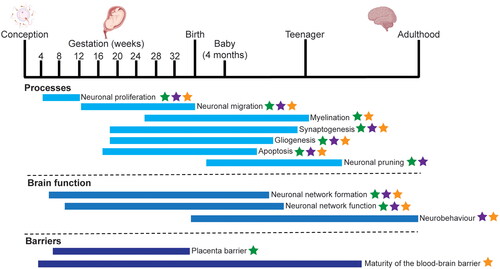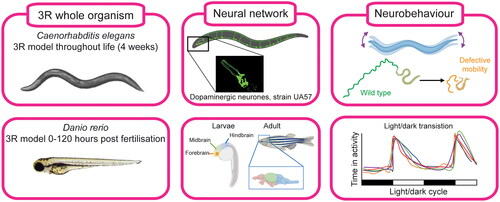Figures & data
Figure 1. The cellular processes involved in brain development. The key biological processes in human brain development are shown, with their approximate time span. The majority of processes occur in utero, with some of the more complex processes, such as myelination, synaptogenesis and neuronal specification, occurring at later stages of gestation and during early childhood. Specifically, the blood brain barrier continues to form until the early teenage years. The processes which can be modelled in cell culture (green stars), Caenorhabditis elegans (purple stars) and zebrafish, Danio rerio (orange stars) are indicated where these processes are present and can be measured. This information is based on literature (Keeney et al. Citation2015; Hessel et al. Citation2018; Sun and Hobert Citation2023) and generated with BioRender.com.

Table 1. Key events that are crucial to adverse outcomes in developmental neurotoxicity.
Figure 2. Use of whole organism models in developmental neurotoxicity. The nematode Caenorhabditis elegans is a 3 R model throughout the duration of the 4-week life span. The zebrafish Danio rerio, is only considered a 3 R-model until 120 h post fertilisation (hpf). Both models develop a Central nervous system and neurobehaviour can be tested in various assays, for C. elegans, a mobility assays can be undertaken (Hughes et al. Citation2022) and in zebrafish larvae the light/dark transition test (Atzei et al. Citation2021). Figure generated with BioRender.com using authors’ own images and relevant references (Kalueff et al. Citation2014; Kozol et al. Citation2016; Hughes et al. Citation2022).

